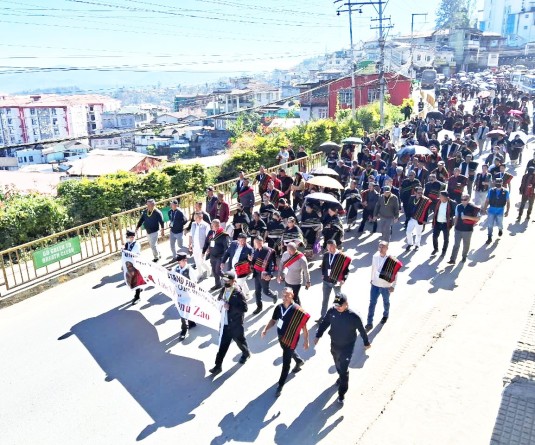
• Import level of pigs to zero by 2025
• Attain self sufficiency in pork production by 2026
• Export surplus by 2030
Morung Express News
Dimapur | October 7
Nagaland Parliamentary Secretary for Animal Husbandry & Veterinary Services, S Chuba Longkumer, said it is the endeavour of the state government to narrow down the import level of pigs to zero by 2025, attain self sufficiency in pork production by 2026 and export the surplus by 2030 as outlined in the government’s ‘.’
“It is our vision that by 2030 our state will be tagged as pork production hub of the country,” the Parliamentary Secretary said in his address at the launching programme of artificial insemination (IA) in pigs in Nagaland on a pilot basis in Dimapur on Saturday.
Chuba said after framing the state’s Pig Breeding Policy, launching of IA in pigs is another landmark achievement. He said Naga society as a whole consume pork resulting in high demand and short supply and the state had to import pigs for consumption to the tune of Rs. 73 crores during 2016-17. “Due to this reason, Government of Nagaland had identifies piggery as a thrust area for development. Therefore, funds under State Plan, CSS, NEC including credit linkages are focused towards piggery development so as to enable the piggery farmers and entrepreneurs to participate in its production,” he said.
Chuba said to achieve the state government’s target and also the Prime Minister’s concept of doubling the farmers’ income by 2022, the quantum of piglets to be produced within the state has to be increased two to three folds. He also informed that the state presently requires 3 lakh quality piglets for its rural farmers.
“To address these shortfalls, the answer lies in artificial insemination on pigs in the state on a war footing and mission mode. Every rural household rearing one or two pigs have to be upscaled to 4-5 pigs in order to achieve the target within the time frame”, the parliamentary secretary said.
Chuba further said to achieve the target, active participation of various implementing agencies and stakeholders including ILRI, NRCP, Tata Trust, NEIDA, department of AH & VS and farmers, is required.
“I hope with the usage of specific boar line, we will be able to develop a known variety of Naga pig having premium cuts, high productive and reproductive traits including efficient feed conversion ratio, which in future shall create prospects for export as part of Look East Policy,” he said.
Regional representative, ILRI-South Asia, Dr. H Rahman, who spoke on ILRI’s plan for livestock development in NE India, said of the seven indigenous breed of pigs found in India, four are from NE India. Rahman said as per the 2012 livestock Census, there is a slight increase in exotic pig breeds and decrease in indigenous breeds. Stressing on development of piggery in NE and propagating indigenous pig breeds, Rahman also said even pig feeds can be produced in the region itself as NE is store house of nutritional plants and trees.
Dwelling on ‘Plan for piloting AI in pigs in Nagaland’, Ram Deka, scientist, ILRI, said since Nagaland state tops all the states in per capita consumption of pork, the state should be made the hub of pig development systems in India. He said ILRI which assisted the state government on drafting the Pig breeding policy would also assist in follow up IA programmes in the state.
Principal scientist, NRCP, Dr. Tamuli, informed that in India, IA in pigs first started in 1982and in the North East in Mizoram, Meghalaya, Arunachal Pradesh and finally Nagaland. Tamuli also spoke on the benefits of IA system including doubling of farmers’ income and elimination of diseases in pigs.
Joint director, AH & VS, Dr. David and Sentimongla Kechuchar of NEIDA projects in Nagaland also addressed the gathering, which included farmers from villages under Dimapur district.
Commissioner & secretary, AH & VS, MK Mero who chaired the programme, gave the concluding remarks.


.jpg)


.jpg)
